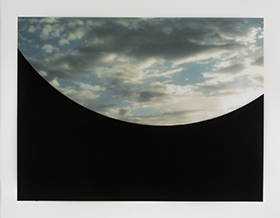PARCHED | INVERTED LANDSCAPES
Susan Goethel Campbell
August 1 – September 17, 2017


PARCHED | INVERTED LANDSCAPES
Exhibition Statement
This exhibition contains formal expressions of our relationship with the physical environment. From picture to process, the complex system we know as earth is portrayed through a variety of materials and formats. Our attention is focused on familiar materials i.e. grass, earth, seeds that are decontextualized from their natural environment and molded into unnatural forms. Our perception toggles between object and field, solid and void, nature and culture. There are moments of confusion, what we are looking at is not easily defined as landscape in the sense of the Picturesque. Uncertainty may be uncomfortable but it offers up the possibility of mystery. Not being able to name something realigns imagination with the body.





Exhibition Essay
Susan Goethel Campbell turns landscape art upside down to dislodge humankind’s assumption of its centrality within the natural environment. An innovative printmaker, Campbell redefines the medium, accepting as a “print” any art object made—with or without a printing press, flat or volumetric—by transferring images between different surfaces. Campbell expands the scope of printmaking to examine the contact border between human consumer culture and its imprint on the natural environment. For instance, in her Ground series of installations, Campbell makes printing “plates” or molds from human garbage like packaging trays and disposable water bottles. Into these molds, Campbell sows grass seeds and soil. As these seeds germinate, they slowly grow into the hollow spaces of the molds, forming biological 3-D prints. Dense root fibers now take the shape of water bottles and iPhones while tufts of green grass flow out of the printing trays. When Campbell ceases watering the trays, the sculptures dry into sisal-like mats. Campbell then arranges these clumps in grids on the floor, pulling many from their molds and turning them upside down to expose the root shapes. These installations illustrate nature’s ability to flourish even in refuse while documenting consumer culture through its trash.
With her Ground artworks, Campbell inverts the environmentalist’s critique of planned obsolescence, the capitalist practice of ensuring a product’s limited shelf life to encourage its replacement rather than repair. Campbell does not discount the environmentalist rebuke that obsolete plastic goods wind up overwhelming our landfills and oceans. She insists, however, not on the product’s obsolescence, but on our own: when humans disappear, new life will instantly sprout in our footprints. This critique joins the trend in eco-art against anthropocentrism—the narcissistic practice of framing all environmental crises in exclusively human terms. Her inverted root installations—which effectively offer us a subterranean perspective as if we were looking at these roots from six feet underground—destabilize our self-centered views and insist that we approach nature with humility and on its own terms.
Many of the other works in this exhibition similarly challenge the centrality of human perspective. In Chasing Venus: 180 degrees, a lyrical time-lapse video diptych with accompanying video stills, Campbell positions a camera upward over the Canadian Rockies. One video monitor traces Venus’s gentle, steady trail across the night sky while the other screen shows the same scene upside down. The two views show a planet in transit entirely indifferent to its human gazers. Similarly, in her Dune digital prints, Campbell juxtaposes the transient nature of sand dunes with human figures, offering a memento mori not focused on human mortality so much as on the universal conditions of movement and change.
It would be wrong to interpret Campbell’s art as pessimistic in its assessment of our environmental predicament. Though cautionary, these works ultimately pay homage to life’s ability to thrive in inhospitable situations. Like the dandelion’s parachute seeds that Campbell carefully gathers for her Seasonal Flyers series, life is always poised and ready to regenerate in even the most parched, damaged environments.
John Corso Esquivel
Doris and Paul Travis Associate Professor of Art History Oakland University, MI

About | Susan Goethel Campbell
Susan Goethel Campbell creates multi-disciplinary work that considers the contemporary landscape to be an emergent system where nature, culture and the engineered environment are indistinguishable from one another. Central to her practice is the collection, documentation and observation of seasonal change and ephemera in both natural and artificial environments. Her work is realized in several formats, including installation, video, prints and drawings, as well as projects that engage communities to look at local and global environments.
Campbell earned an MFA in printmaking from Cranbrook Academy of Art. Her work has been exhibited internationally in Belgium, Germany, Switzerland and Slovenia and nationally throughout the US, including, National Museum of Women in the Arts, Queens Art Museum, Crystal Bridges Museum, Museum of Contemporary Art Detroit, Grand Rapids Art Museum, the Detroit Institute of Arts, The Drawing Center, and The International Print Center New York. In 2009 she was one of 18 artists selected for the inaugural Kresge Artist Fellowship.
Campbell has been awarded residencies at the Banff Centre for the Arts, Flemish Center for Graphic Arts, the Jentel Foundation, Beisinghoff Print residency and the Print Research Institute of North Texas. She taught studio art for 15 years at the College for Creative Studies in Detroit and has been a visiting artist in numerous institutions in the United States and abroad. Her work is in the collection of the National Museum of Women in the Arts, New York Public Library, Detroit Institute of Arts, Toledo Museum of Art and the University of Michigan Special Collections Library.
Link here to online catalog – images and text
Exhibition Folio
Artist Website
To inquire about works in the exhibition contact us at 828.765.6211 or via email at gallery@penland.org


The Penland Gallery extends many thanks to Susan Goethel Campbell for her vision and dedication – without which this exhibition would not be possible. Susan is indeed a rare individual and we are fortunate to share this exhibition with our visitors.


